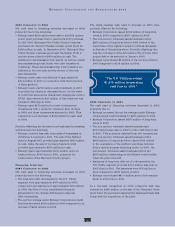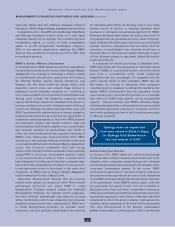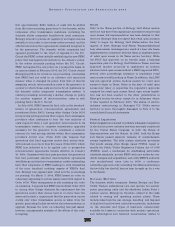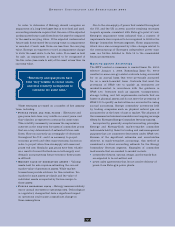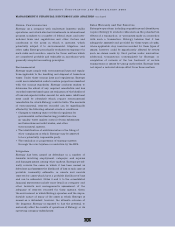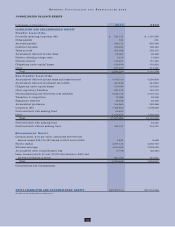Entergy 2003 Annual Report Download - page 45
Download and view the complete annual report
Please find page 45 of the 2003 Entergy annual report below. You can navigate through the pages in the report by either clicking on the pages listed below, or by using the keyword search tool below to find specific information within the annual report.
43
ENTERGY CORPORATION AND SUBSIDIARIES 2003
COST ESCALATION FACTORS - Entergy’s decommis-
sioning revenue requirement studies include an assumption
that decommissioning costs will escalate over present cost
levels by annual factors ranging from approximately
CPI-U to 5.5%. A 50 basis point change in this assumption
could change the ultimate cost of decommissioning a
facility by as much as 11.0%.
TIMING - In projecting decommissioning costs, two
assumptions must be made to estimate the timing of
plant decommissioning. First, the date of the plant’s
retirement must be estimated. The expiration of the
plant’s operating license is typically used for this
purpose, or an assumption could be made that the plant
will be relicensed and operate for some time beyond the
original license term. Second, an assumption must be
made whether decommissioning will begin immediately
upon plant retirement, or whether the plant will be held
in “safestore” status for later decommissioning, as
permitted by applicable regulations. While the impact of
these assumptions cannot be determined with precision,
assuming either license extension or use of a “safestore”
status can significantly decrease the present value of
these obligations.
SPENT FUEL DISPOSAL - Federal regulations require
the Department of Energy to provide a permanent
repository for the storage of spent nuclear fuel, and
recent legislation has been passed by Congress to
develop this repository at Yucca Mountain, Nevada.
However, until this site is available, nuclear plant
operators must provide for interim spent fuel storage
on the nuclear plant site, which can require the
construction and maintenance of dry cask storage
sites or other facilities.
The costs of developing and maintaining these facilities
can have a significant impact (as much as 16% of
estimated decommissioning costs). Entergy’s decommis-
sioning studies include cost estimates for spent fuel
storage. However, these estimates could change in the
future based on the timing of the opening of the Yucca
Mountain facility, the schedule for shipments to that
facility when it is opened, or other factors.
TECHNOLOGY AND REGULATION - To date, there is
limited practical experience in the U.S. with actual
decommissioning of large nuclear facilities. As experi-
ence is gained and technology changes, cost estimates
could also change. If regulations regarding nuclear
decommissioning were to change, this could have a
potentially significant impact on cost estimates. The
impact of these potential changes is not presently
determinable. Entergy’s decommissioning cost studies
assume current technologies and regulations.
The implications of these estimates vary significantly
between Entergy’s U.S. Utility and Non-Utility Nuclear
businesses. Separate discussions of these implications by
business segment follow.
U.S. Utility
Entergy collects substantially all of the projected costs of
decommissioning the nuclear facilities in its U.S. Utility
business segment through rates charged to customers,
except for portions of River Bend, which is discussed in
more detail below. The amounts collected through rates,
which are based upon decommissioning cost studies, are
deposited in decommissioning trust funds. These collec-
tions plus earnings on the trust fund investments are
generally estimated to be sufficient to fund the future
decommissioning costs. For the U.S. Utility segment, if
decommissioning cost study estimates were changed and
approved by regulators, collections from customers would
also change.
Approximately half of River Bend is not currently subject
to cost-based ratemaking. When Entergy Gulf States
obtained the 30% share of River Bend formerly owned by
Cajun, Entergy Gulf States obtained decommissioning trust
funds of $132 million, which have since grown to almost
$150 million. Entergy Gulf States believes that these funds
will be sufficient to cover the costs of decommissioning this
portion of River Bend, and no further collections or deposits
are being made for these costs. Additionally, under the
Deregulated Asset Plan in the Louisiana jurisdiction of
Entergy Gulf States, a portion of River Bend (approximately
16% of its total capacity) is excluded from rate base, and no
amounts have been or are being collected for decommissioning
for this portion of the plant.
Non-Utility Nuclear
In conjunction with the purchase of Entergy’s Non-Utility
Nuclear facilities, Entergy assumed the decommissioning
obligations and received the related decommissioning trust
funds (except for the NYPA acquisition, in which NYPA
retained the decommissioning obligations for the Indian
Point 3 and FitzPatrick units). Based on decommissioning
cost studies and expected plant operation lives, Entergy
believes that the amounts in the trust funds will be
sufficient to fund future decommissioning costs without
additional deposits from Entergy.
As Entergy has assumed these decommissioning obliga-
tions without any further external source of funding,
changes in estimates of decommissioning costs for these
units will have a direct impact on Entergy’s financial
position and results of operations.


